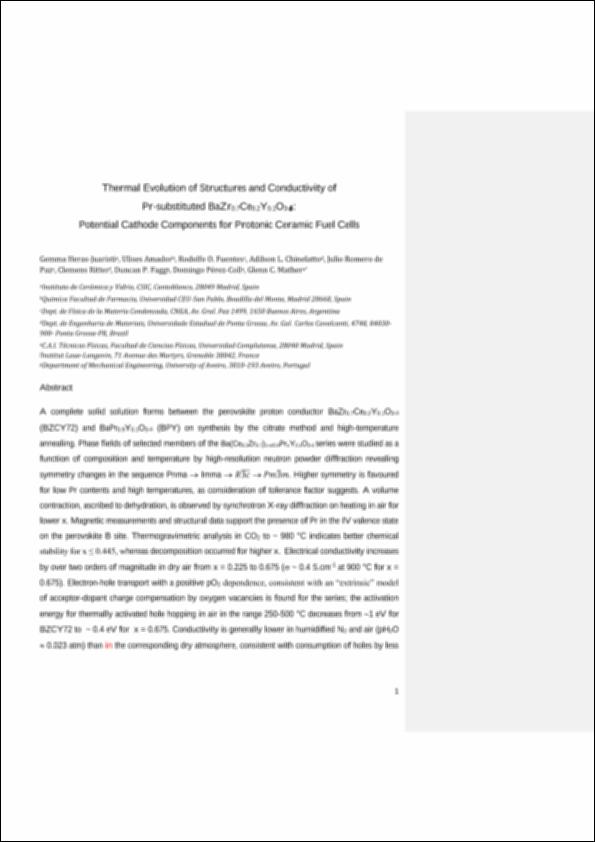Por favor, use este identificador para citar o enlazar este ítem:
http://hdl.handle.net/10637/14818Thermal evolution of structures and conductivity of Pr-substituted BaZr0.7Ce0.2Y0.1O3−δ: potential cathode components for protonic ceramic fuel cells
| Título : | Thermal evolution of structures and conductivity of Pr-substituted BaZr0.7Ce0.2Y0.1O3−δ: potential cathode components for protonic ceramic fuel cells |
| Autor : | Heras-Juaristi, Gemma Amador Elizondo, Ulises Julio Fuentes, Rodolfo O. Chinelatto, A. L. Romero de Paz, J. Ritter, Clemens Fagg, Duncan P. Pérez-Coll, Domingo Mather, Glenn C. |
| Materias: | Perovskite; Conductivity; Thermogravimetry; Cathode |
| Editorial : | Royal Society of Chemistry |
| Citación : | Heras-Juaristi, Gemma, Amador, Ulises, Fuentes, Rodolfo O., Chinelatto, Adilson L., Romero de Paz, Julio, Ritter, Clemens, Fagg, Duncan P., Pérez-Coll, Domingo, Mather, Glenn C.", Thermal evolution of structures and conductivity of Pr-substituted BaZr0.7Ce0.2Y0.1O3-y: potential cathode components for protonic ceramic fuel cells, J. Mater. Chem. A", 2018 6(13) 5324-5334, DOI: 10.1039/C7TA09570H |
| Resumen : | A complete solid solution forms between the perovskite proton conductor BaZr0.7Ce0.2Y0.1O3−δ (BZCY72) and BaPr0.9Y0.1O3−δ (BPY) on synthesis by the Pechini method and high-temperature annealing. Phase fields of selected members of the Ba(Zr0.7Ce0.2)1−(x/0.9)PrxY0.1O3−δ series were studied as a function of composition and temperature by high-resolution neutron powder diffraction revealing symmetry changes in the sequence Pnma → Imma → Image ID:c7ta09570h-t1.gif → Pm[3 with combining macron]m. Higher symmetry is favoured for low Pr contents and high temperatures, as consideration of tolerance factor suggests. A volume contraction, ascribed to dehydration, is observed by synchrotron X-ray diffraction on heating in air for lower x. Magnetic measurements and structural data support the presence of Pr in the IV valence state on the perovskite B site. Thermogravimetric analysis in CO2 to ∼1253 K indicates better chemical stability for x ≤ 0.445, whereas decomposition occurred for higher x. Electrical conductivity increases by over two orders of magnitude in dry air at lower temperature from x = 0.225 to 0.675; total conductivity reaches a value of 0.4 S cm−1 at 1173 K for x = 0.675. The series exhibits electron–hole transport with a positive pO2 dependence which increases with temperature, consistent with participation of oxygen vacancies in charge compensation of the Y3+ acceptor dopant. The activation energy for thermally activated hole hopping in air in the range 523–773 K decreases from ∼1 eV for BZCY72 to ∼0.4 eV for x = 0.675. Conductivity is generally lower in humidified N2 and air (pH2O ≈ 0.023 atm) than the corresponding dry atmospheres, consistent with consumption of holes by less mobile protonic species; however for x ≤ 0.225 the lower concentration of electron holes concomitant with higher oxygen-vacancy content in N2 results in slightly higher conductivity in wet conditions due to hydration of vacancies. |
| URI : | http://hdl.handle.net/10637/14818 |
| Derechos: | http://creativecommons.org/licenses/by-nc-nd/4.0/deed.es |
| ISSN : | 2050-7496 |
| Fecha de publicación : | 20-nov-2017 |
| Centro : | Universidad San Pablo-CEU |
| Aparece en las colecciones: | Facultad de Farmacia |
Los ítems de DSpace están protegidos por copyright, con todos los derechos reservados, a menos que se indique lo contrario.


